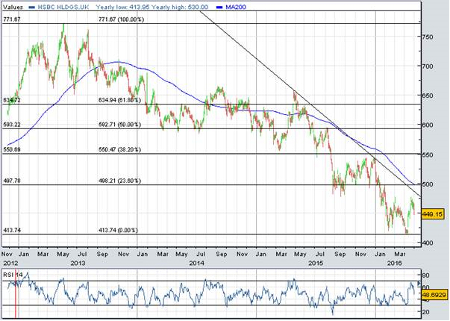HSBC joy disappears quickly
3rd May 2016 14:22
by Lee Wild from interactive investor
Share on
Volatile financial markets made it a tricky first quarter for . The bank must keep cutting costs to offset a decline in revenue, and it did beat expectations on both measures. A smaller-than-anticipated fall in profit also surprised the City. However, after rising as much as 3% early on Tuesday, the shares turned tail, implying more is required to restore confidence.
Profit before tax fell by 14%, or $953 million (£651 million), to $6.1 billion in the three months to 31 March - "resilient in tough market conditions," claimed chief executive Stuart Gulliver. Adjusted profit was down 18% at $5.4 billion, which the lender blamed on a 4% decline in adjusted revenue to $13.9 billion and higher than expected loan impairment charges of $1.16 billion.
"Market uncertainty led to extreme levels of volatility in January and February, which affected our ability to generate revenue in our Markets and Wealth Management businesses," warned Gulliver. "However, our diversified, universal-banking business model helped to cushion the impact through growth in other parts of the bank. Commercial Banking continued its momentum in spite of the slow-down in global trade."
According to analysts at UBS, adjusted profit was 11% above consensus estimates of $4.9 billion. Crucially, revenue was 2% better than City forecasts and costs 6% ahead of expectations.
"For a company with a mixed track record of delivering on costs, the operating expense outcome is especially noteworthy," said UBS. "Though some of this is down to foreign exchange moves, both expenses and income beat market expectations, with HSBC reconfirming its target of delivering end-2017 run rate costs in line with 2014 levels."

Admittedly, the common equity tier 1 capital of 11.9% fell short, although by only 20 basis points, as so-called risk-weighted assets (RWAs) edged up to $1.1 trillion.
At current levels, HSBC trades on about 0.8 times tangible net asset value for a 9% forecast return on tangible equity. A forward price/earnings ratio of less than 10 seems modest, and, with the dividend held at 10 US cents per share this time, there's a prospective dividend yield of almost 8%, according to UBS analyst Jason Napier.
HSBC is certainly making progress, but many analysts still worry about its ability to keep paying the dividend. That's despite finance director Iain Mackay telling them either "significant downward pressure" on earnings, or "significant upward pressure" on regulatory capital requirements could endanger the payout.
From a technical perspective, chartist Alistair Strang said recently that HSBC shares must move above 490p to signal growth. "We'd certainly experience a quiver if the share price now manages below [410p] currently, as an express ride down to an initial 320p makes sense," he said. We're not there yet, but watch out.
This article is for information and discussion purposes only and does not form a recommendation to invest or otherwise. The value of an investment may fall. The investments referred to in this article may not be suitable for all investors, and if in doubt, an investor should seek advice from a qualified investment adviser.